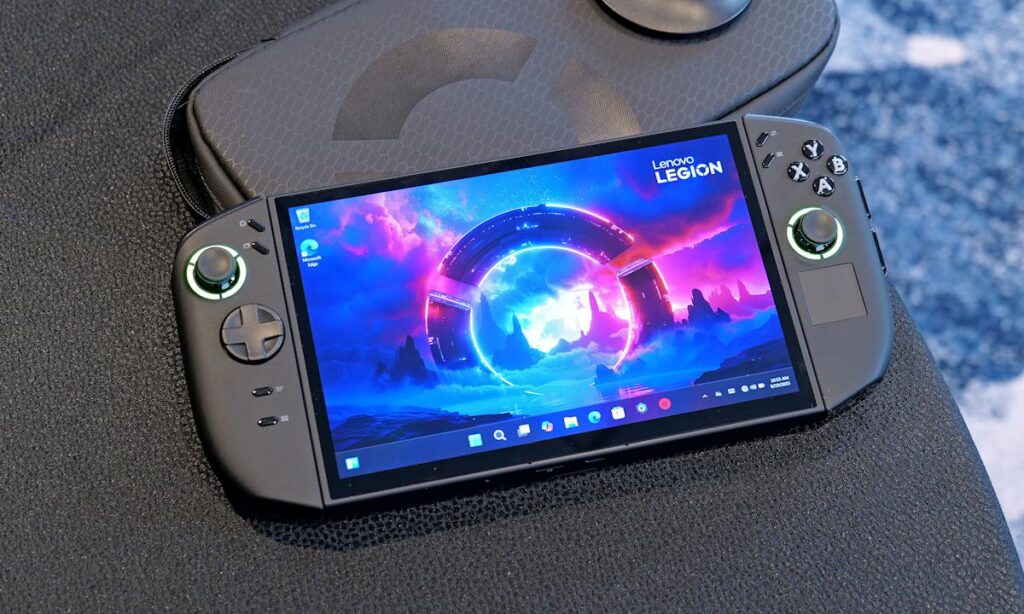
At the IFA 2025 in Berlin, Lenovo has officially unveiled its latest gaming handheld, the Legion Go 2, offering a deeper dive into its specifications, pricing, and availability. This announcement follows an early design preview earlier this year, which teased the gaming community with a glimpse of Lenovo’s next-generation portable gaming device.
The Legion Go 2 maintains much of the aesthetic appeal of its predecessor, featuring the same general shape and detachable controllers. It boasts an 8.8-inch OLED display with a variable 144Hz refresh rate and VESA HDR TrueBlack 1000 certification. Notably, Lenovo continues to offer the unique feature of using the right controller as a vertical mouse, or FPS mode, when paired with the handheld’s included puck/stand. Additional features like Hall Effect joysticks, a built-in touchpad, a kickstand, and dual USB 4 ports remain intact.
Design and Usability: A Closer Look
While the overall design remains largely unchanged, Lenovo has introduced minor cosmetic updates, such as new paint colors on the shoulder buttons. The Legion Go 2 also comes bundled with a case, a thoughtful inclusion that sets it apart from many competitors, except for the Steam Deck. However, the detachment process for the controllers remains the same, which some users might find cumbersome compared to the newer magnetic system found in devices like the Switch 2’s Joy-Con.
Internal Upgrades: Power and Performance
The real advancements in the Legion Go 2 lie beneath the surface. The device can now be equipped with up to an AMD Ryzen Z2 Extreme chip, 32GB of RAM, and 2TB of PCIe Gen 4 storage. For those needing even more space, a microSD card reader is available. Perhaps the most significant upgrade is the battery, with the Legion Go 2 featuring a 74Whr battery, a 50 percent increase from the original’s 49.2 Whr cell.
During a brief hands-on session, the demo unit’s performance was difficult to fully assess due to the limited number of pre-installed games. However, the Legion Space app appeared more responsive and polished, though it may not match the seamless game integration and user interface enhancements expected on the ROG Xbox Ally.
Market Position and Pricing
The Legion Go 2 is poised to be a more refined and powerful successor, retaining popular features like the large OLED screen and detachable controllers. Despite its improvements, the device remains on the bulkier side, which is expected given its substantial 8.8-inch display. For gamers comfortable with a heftier, Windows-based handheld, the Legion Go 2 presents a compelling option.
However, the price may be a sticking point for some. The Legion Go 2 is anticipated to launch in October with a starting price of $1,049, a notable increase from the original’s $700 base price. This figure is likely for a model with a Ryzen Z2 chip, suggesting that those seeking the more powerful Z2 Extreme processor should prepare for additional costs. The higher price point may prompt potential buyers to consider more affordable alternatives like the Steam Deck.
Implications for the Gaming Handheld Market
The introduction of the Legion Go 2 reflects Lenovo’s commitment to pushing the boundaries of portable gaming performance. However, its pricing strategy may influence consumer decisions, especially in a market where cost-effective options are highly valued. The device’s enhancements, while impressive, must be weighed against its affordability and the competition it faces from other gaming handhelds.
As Lenovo prepares to release the Legion Go 2, the gaming community will be watching closely to see how it performs in real-world scenarios and whether its price point can be justified by its capabilities. The coming months will reveal whether Lenovo’s latest offering can capture the interest of gamers seeking high performance in a portable package.







